Sleeve Anchor vs. Wedge Anchor - Differences
When securing heavy loads to concrete, masonry, or other solid materials, choosing the right type of anchor is crucial. Two popular choices are sleeve and wedge anchors, but which is suitable for your needs? Let’s break down their key differences, uses, and benefits so you don’t mess things up.
What Are Sleeve Anchors?
Sleeve anchors are versatile and commonly used for medium-duty applications. These anchors expand against the hole's walls, creating a secure hold in concrete, brick, and block materials.
How Sleeve Anchors Work
When you tighten a sleeve anchor, the sleeve expands, gripping the material firmly. This makes them ideal for hollow base materials where a stronghold is necessary.
Benefits of Sleeve Anchors
Sleeve anchors offer numerous benefits that make them a popular choice. Their versatility allows them to use various materials, including concrete, brick, and block. They are also quick and straightforward to install, making projects more efficient. Additionally, sleeve anchors are widely available in different sizes and materials, ensuring you can find the perfect fit for your needs.
What Are Wedge Anchors?

Wedge anchors are known for their strong holding power, perfect for heavy-duty applications. They are designed specifically for use in solid concrete. Fastenere offers them in:
- Grade 316 (Marine-grade and Chlorine-resistant)
- 304 stainless steel (used outdoors for items submerged in water)
- galvanized steel (used outdoors when some moisture is present)
- zinc-plated steel (used both indoors and outdoors where no moisture is present)
How Wedge Anchors Work
Wedge anchors work by expanding a clip at the base of the anchor when tightened, which locks the anchor in place within the concrete.
Benefits of Wedge Anchors
Wedge anchors offer several compelling benefits. Their high load capacity makes them perfect for heavy-duty applications, while their durability ensures excellent holding power in solid concrete.
Sleeve Anchors Vs. Wedge Anchors
| Sleeve Anchors | Wedge Anchors | |
| Application and Material Suitability | Best for hollow materials and a range of base materials (concrete, brick, block) | Designed for solid concrete applications only. |
| Installation Process | It is easier and faster to install, with fewer steps involved. | Requires precise drilling and installation for maximum effectiveness. |
| Cost Considerations | Generally less expensive, they are cost-effective for medium-duty applications. | Pricier but justified by their superior load-bearing capacity and durability. |
| Load Capacity (varies with sizing) | Typically support up to 200-1000 lbs. | It can support loads up to 6000 lbs or more. |
| Installation Time | Installing can be completed in about 2-3 minutes per anchor. | Due to the need for precise drilling and securing may take slightly longer, around 5-10 minutes per anchor. |
When to Use Sleeve Anchors
When you need a reliable solution for securing items to different materials, sleeve anchors are your best friend. Here are some prime scenarios:
- Perfect for securing fixtures like electrical boxes, large flat-screen TV sets, handrails, and shelving.
- Excellent for diverse construction tasks where various base materials come into play.
They are perfect for securing shelving units, handrails, and light fixtures to concrete, brick, or block walls in home renovations.
In commercial installations, sleeve anchors prove invaluable for medium-duty applications, such as installing signs or mounting equipment, demonstrating their reliability and adaptability across different projects.
When to Use Wedge Anchors

When strength and stability are paramount, wedge anchors are your go-to solution. Here are some critical applications:
- It is perfect for securing structural elements, large antennas, park benches, fire sprinklers, elevators, and other heavy equipment.
- It is the best choice for projects involving only solid concrete.
They are essential for anchoring heavy machinery to concrete floors in industrial projects. For structural applications, they are crucial for securing steel columns and beams to concrete foundations.
How to Choose Between Wedge or Sleeve Anchors
Ensure your project’s success by considering these expert tips:
- Assess the material to determine if you’re working with hollow or solid materials.
- Evaluate the weight and stress the anchor will need to support.
- Review installation requirements and confirm you have the right tools and expertise.
Frequently Asked Questions
Q1: Can sleeve anchors be used in solid concrete?
Yes, but they are generally more effective in hollow materials or with different base materials.
Q2: Are sleeve and wedge anchors reusable?
Both sleeve and wedge anchors are not recommended to be removed and reused.
Q3: Can wedge anchors be installed on Green Concrete?
Before drilling and installing a wedge anchor, the concrete must have had a minimum of 28 days to set correctly.
Q4: Which anchor is more cost-effective?
Sleeve anchors are typically less expensive and suitable for medium-duty applications, making them a more cost-effective choice for many projects.
Q5: Can I use wedge anchors in brick or block?
Wedge anchors are specifically designed for solid concrete.
Additional Considerations
Environmental factors should also be considered when selecting an anchor. For instance, if your project is in a coastal area or a place with high humidity, you might opt for anchors made of stainless steel or galvanized materials to resist corrosion.
Also, think about the potential need for future adjustments or removals. While wedge anchors offer incredible holding power, they are not easily removed once set. If there's a chance you might need to move or adjust the anchor, then use special removable concrete anchors.
Follow these expert tips and safety considerations to ensure your projects are safe and successful. Start by assessing whether you’re working with hollow or solid materials and evaluating the weight and stress the anchor needs to support. Meticulous installation is crucial—always follow the manufacturer’s instructions to avoid structural failures.
Moreover, performing load tests on critical applications can help verify that the anchors will hold under expected stress. By reviewing installation requirements and confirming you have the right tools and expertise, you can ensure a reliable outcome.
We hope you find this guide helpful. Choose the best anchors for your project and start confidently.

